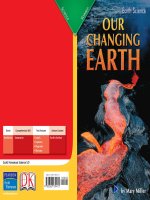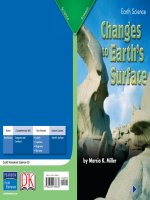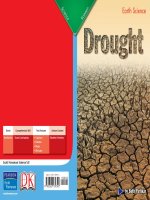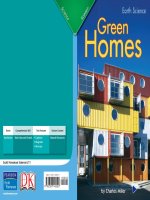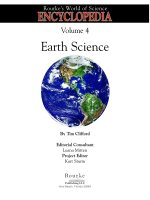earth science green homes
Bạn đang xem bản rút gọn của tài liệu. Xem và tải ngay bản đầy đủ của tài liệu tại đây (5.19 MB, 14 trang )
Scott Foresman Science 6.11
Genre Comprehension Skill Text Features Science Content
Nonfi ction Main Idea and Details • Captions
• Diagrams
• Glossary
Natural Resources
ISBN 0-328-14002-3
ì<(sk$m)=beaacc< +^-Ä-U-Ä-U
14002_01-04_CVR_FSD.indd Cover114002_01-04_CVR_FSD.indd Cover1 5/25/2005 4:33:16 PM5/25/2005 4:33:16 PM
Scott Foresman Science 6.11
Genre Comprehension Skill Text Features Science Content
Nonfi ction Main Idea and Details • Captions
• Diagrams
• Glossary
Natural Resources
ISBN 0-328-14002-3
ì<(sk$m)=beaacc< +^-Ä-U-Ä-U
14002_01-04_CVR_FSD.indd Cover114002_01-04_CVR_FSD.indd Cover1 5/25/2005 4:33:16 PM5/25/2005 4:33:16 PM
1. How do eco-friendly building materials help
the environment?
2. What are some advantages of a rammed earth
wall, such as cob or adobe?
3. Name two kinds of renewable energy that can be
used in green homes.
4.
How are green homes similar
to other types of construction and how are they
different?
5.
Main Idea and Details Green homes conserve
resources in their design, construction, and daily
use. Describe some of the ways that green homes
conserve fossil fuels. Include details from the
book to support your answer.
What did you learn?
Extended Vocabulary
building materials
eco-friendly
heat island
organic garden
rammed earth home
straw bale home
turf roof
Vocabulary
acid precipitation
coal
fossil fuel
geothermal energy
natural gas
nonrenewable resource
petroleum
renewable resource
Picture Credits
Every effort has been made to secure permission and provide appropriate credit for photographic material.
The publisher deeply regrets any omission and pledges to correct errors called to its attention in subsequent editions.
Photo locators denoted as follows: Top (T), Center (C), Bottom (B), Left (L), Right (R), Background (Bkgd).
Opener: Nicholas Kane/Alamy Images; 1 Gideon Mendel/Corbis; 4 Benedict Luxmoore/Arcaid;
5 (TR) Gideon Mendel/Corbis; 8 Alan Sirulnikoff/Photo Researchers, Inc.; 9 (TR) Mary Ashby/Arcaid;
10 Robert Harding World Imagery/Alamy Images; 12 Eric Draper/AP/Wide World Photos;
13 (T) Nicholas Kane/Alamy Images, (BR) Sam Barcroft/Rex Features, Limited; 15 Martin Bond/Peter Arnold, Inc.;
16 Getty Images; 20 (B) Tony Freeman/PhotoEdit; 23 Bruce Harber/Ecoscene.
Scott Foresman/Dorling Kindersley would also like to thank: 17 (R) Cole Associates/DK Images;
22 (BR) Cole Associates/DK Images.
Unless otherwise acknowledged, all photographs are the copyright © of Dorling Kindersley, a division of Pearson.
ISBN: 0-328-14002-3
Copyright © Pearson Education, Inc. All Rights Reserved. Printed in the United States of America.
This publication is protected by Copyright, and permission should be obtained from the publisher prior to any
prohibited reproduction, storage in a retrieval system, or transmission in any form by any means, electronic,
mechanical, photocopying, recording, or likewise. For information regarding permission(s), write to
Permissions Department, Scott Foresman, 1900 East Lake Avenue, Glenview, Illinois 60025.
3 4 5 6 7 8 9 10 V010 13 12 11 10 09 08 07 06 05
14002_01-04_CVR_FSD.indd Cover214002_01-04_CVR_FSD.indd Cover2 5/25/2005 4:33:35 PM5/25/2005 4:33:35 PM
by Charles Miller
14002_05-28_FSD.indd 114002_05-28_FSD.indd 1 5/25/2005 4:35:26 PM5/25/2005 4:35:26 PM
What You Already Know
Everything you do—eating, traveling home from school,
and even breathing—uses natural resources. Air and water are
examples of natural resources that you use directly. Building
materials, electricity, and fabric for your clothes are things that
are made from natural resources.
Natural processes replace some things, called renewable
resources, as they are used. Sunlight, energy from the wind, and
water in streams can be renewable resources. Other things, called
nonrenewable resources, cannot be replaced as fast as they are
used. Nonrenewable resources include fossil fuels, minerals,
and water in underground reservoirs.
Fossil fuels are the main source of energy for transportation,
heat, and electricity. The process that makes them requires
millions of years. As the remains of living organisms slowly
decay from heat and pressure below the surface of Earth, they
are converted into fossil fuels. This process cannot replenish
fossil fuels as quickly as they are used.
2
People need electrical energy to
light their homes and offi ces.
14002_05-28_FSD.indd 214002_05-28_FSD.indd 2 5/25/2005 4:35:53 PM5/25/2005 4:35:53 PM
Coal, a solid fossil fuel that is
burned for heat and electricity, forms
from the remains of plants that lived
in swamps millions of years ago.
Petroleum is a liquid fossil fuel that
is used to make gasoline and other
transportation fuels and home heating
oil. It forms from the decay of buried
remains of marine plants and animals
over a very long time. Natural gas, a
mixture of gases that can be burned
for heat and to generate electricity, is
usually found in the same places as
coal and petroleum.
Burning fossil fuels contributes
to pollution by releasing harmful
materials into the atmosphere. These
materials, which contain nitrogen and
sulfur, combine with water vapor to
make acids. The acids fall to the ground
in rain and snow, creating acid precipitation,
which has harmful effects on plants and animals.
People need energy for transportation, growing food, and
heating and lighting homes. However, there are some energy
sources that do not consume renewable resources or cause
pollution. For example, electricity can be produced by wind
turning the blades of large turbines or sunlight falling on solar
cells. Some renewable sources of heat energy are used directly.
These include sunlight and geothermal energy, the energy from
heat inside Earth.
3
wind turbines
14002_05-28_FSD.indd 314002_05-28_FSD.indd 3 5/25/2005 4:36:03 PM5/25/2005 4:36:03 PM
Green Homes
Everyone needs a home. Along with food, water, and air,
shelter is a basic part of human survival. Unlike many animals,
people do not have fur or carry a shell for protection. Your
home keeps you warm in cold weather and cool in hot weather.
It protects you from rain, wind, and snow.
Unfortunately, building a house affects the environment.
Some of the effects are easy to see. Before people start building,
they remove trees and other plants, change the shape of the land
with heavy equipment, and sometimes disrupt natural water fl ow
patterns. Other effects are less obvious—they may actually occur
hundreds or thousands of miles away or over time. If you have
ever watched a house being built, you know that it takes a lot of
materials, such as wood, steel, glass, and concrete. Many of these
materials are not renewable and must be shipped from far away.
Even after a house is built, it affects the environment, both
local and distant. One of the biggest uses of fossil fuels in the
United States is for heating and lighting homes. Some of these
fuels, such as natural gas and home heating oil, are consumed
in the home to produce heat directly. Others, such as coal, are
converted to electricity to provide heat
and light far away from the place
where they are burned. Most of
the energy consumed in the
United States comes from
nonrenewable fossil fuels.
4
The eco-friendly
apartments in the
United Kingdom
use many of
the building
techniques
described in
this book.
14002_05-28_FSD.indd 414002_05-28_FSD.indd 4 5/25/2005 4:36:08 PM5/25/2005 4:36:08 PM
Many builders and architects
have begun to look for ways to
build houses, apartments, and
other buildings that have less
impact on the environment.
These environment-friendly
homes are planned and built to
use minimal amounts of
nonrenewable resources and to
provide heat and light with the
smallest possible consumption
of fossil fuels.
This cabin is part of a village
designed to minimize
environmental impact.
5
14002_05-28_FSD.indd 514002_05-28_FSD.indd 5 5/25/2005 4:36:19 PM5/25/2005 4:36:19 PM
Building
Materials
Have you ever seen a house being
built? Large trucks deliver building
materials, which are all the basic materials
used in construction. Builders start with
the concrete that forms a platform for the
building. After building the base, workers
frame the house using lumber or steel
framing. The frames are usually covered
on the outside by bricks or by siding made
of aluminum or vinyl plastic, and on the
inside by wallboard made of a mineral
product called gypsum.
Even a small house requires many tons
of building materials, much of it made
from nonrenewable resources. Aluminum,
gypsum, and the iron used to make steel
are mined from the ground. The basic
material for vinyl siding comes from
petroleum, another resource that is not
renewable. Even wood, which is renewable
because new trees can be grown, is being
used faster than new forests can replace it.
An eco-friendly home, one that minimizes
environmental effects, uses as many
renewable materials as possible.
Although forests produce new trees,
so much lumber is used that new
forests must be cut every year.
6
14002_05-28_FSD.indd 614002_05-28_FSD.indd 6 5/25/2005 4:36:34 PM5/25/2005 4:36:34 PM
In addition to consuming resources, many of the materials
used in building conventional homes affect the environment
in other ways. The production of the cement used in concrete
releases large quantities of carbon dioxide, a greenhouse gas.
Common building methods produce large amounts of waste
as standard-sized materials are cut to fi t the space where they
are to be used.
Finally, conventional building techniques require a lot of
energy. Materials such as metal and plastic are produced by
methods that consume large amounts of power in the form of
fossil fuels or electricity. Also, trucks that carry the materials
used in building a house may come from far away. These trucks
consume fuel and produce greenhouse gases as they carry
materials to the building site.
The making of concrete contributes to greenhouse gases in
both the production of cement and its delivery by truck.
Building a typical
house uses many tons
of nonrenewable
resources.
7
14002_05-28_FSD.indd 714002_05-28_FSD.indd 7 5/25/2005 4:36:44 PM5/25/2005 4:36:44 PM
8
Back to Basics
Most of the homes built today use wood or steel frames,
but there are other ways to design a house. A lot of eco-friendly
buildings use techniques that were common before materials
were easily transported. In many places, such as the plains of the
midwestern United States, there are few trees. Today trucks and
railroads deliver lumber and other building materials to these areas.
In the past, people built homes with materials from local sources.
One building material that is easy to fi nd in grasslands is
straw. The Great Plains settlers used bales of straw, the strong
stems of grass and grain plants, as building blocks. In a straw bale
home, bundles of straw are stacked to make a well-insulated wall
that is covered with some type of protective siding on the
outside and with plaster on the inside.
Straw is a renewable resource.
The straw bales
provide inexpensive
and sturdy walls while
using no lumber.
8
14002_05-28_FSD.indd 814002_05-28_FSD.indd 8 5/25/2005 4:36:49 PM5/25/2005 4:36:49 PM
9
Another natural building
material that is available in
most places is mud made by
mixing soil and water. Rammed
earth homes use mud mixed
with other materials and
packed tightly. The rammed
earth dries to form a strong,
waterproof wall. The building
in the illustration to the right
is made of cob, a mixture of
clay, sand, and straw. When
ingredients are mixed in the right proportions, the cob dries
strong, hard, and waterproof. Adobe is another mixture of
clay, sand, and straw. Adobe is used in dry climates, such as the
southwestern part of the United States. Adobe is often shaped
into blocks and dried in the sun to form a bricklike building
block. Cob, adobe, and other forms of rammed earth dry by
evaporation of the water and do not require the high temperature
kilns, or ovens, used in making clay bricks.
All these natural building materials regulate temperature
well. Rammed earth walls are normally thick and absorb heat,
protecting the inside of the building from very high or very low
temperatures outside.
Eco-friendly Paint
Paints contain solid materials mixed in
a liquid. As the paint dries, the liquid
evaporates. In many paints, this liquid
includes chemicals. These chemicals use
nonrenewable resources, and some of
them are toxic. Eco-friendly paints are
made with nontoxic ingredients and
use water as the liquid.
This cottage is built with cob
walls and a thatch roof made
of plant materials.
9
14002_05-28_FSD.indd 914002_05-28_FSD.indd 9 5/25/2005 4:36:56 PM5/25/2005 4:36:56 PM
Take a look at the unique house in the photograph below.
The roof stays green as long as it gets sunshine and rain because
it is covered with turf. This is a grass covering that protects and
insulates the house. Grass, vines, fl owers, and even small trees
can be used to cover a roof.
Why would you want to grow plants on the roof of your
house? One of the best reasons is that turf roofs are good
insulators. The layers of soil and plants keep out heat in the
summer and cold in the winter. This means that much less energy
is required for heating and air-conditioning. A turf roof reduces
carbon dioxide from burning fossil fuels. Plus, the plants release
oxygen into the atmosphere as they grow.
Green on Top
The roof on this building
is made of living grass.
10
14002_05-28_FSD.indd 1014002_05-28_FSD.indd 10 5/25/2005 4:36:59 PM5/25/2005 4:36:59 PM
If you watch a weather report during the summer, you may
notice that cities are usually warmer than the surrounding areas.
A region much warmer than its surroundings is called a heat
island. The city temperature can be as much as six degrees Celsius
warmer than that of the woods or fi elds around it. What could
cause this difference? Look around a city and you see buildings,
streets, and parking lots, but very few plants and trees. While
plants use the solar energy that reaches them to grow, concrete and
asphalt absorb it and release it as heat. Green roofs on houses, as
the one shown to the left, and gardens on top of large buildings
can reduce the heat island effect.
Turf roofs are useful in other ways. In an open fi eld, most of
the rainwater soaks into the ground. If a building covers part of
the fi eld, it forces the rain to run off instead of being absorbed.
But a turf roof is designed to hold water so that the plants can
use it. This reduces the risk of fl ooding from storm runoff.
The turf roof is built in layers to provide water
to the grass while keeping it out of the house.
11
vegetation
drainage and water
retention material
root barrier
roof structure
waterproof roofi ng
material
soil
14002_05-28_FSD.indd 1114002_05-28_FSD.indd 11 7/7/05 3:02:04 PM7/7/05 3:02:04 PM
Reusing Materials
One way to reduce the amount of resources needed for
construction is to reuse materials or even entire buildings. It is
often more effi cient to renovate an old building than to tear it
down. Many modern homes have been built using the basic
structure of an old home or even another type of building,
such as a barn.
Even when buildings are replaced by new structures, many of
the materials can be reused. For example, doors, window frames,
and plumbing fi xtures can be carefully removed and reused just
as they are. Bricks, siding materials, and wooden beams are just
some of the other building materials that are easily reused.
Builders who are interested in recycling have discovered
a number of other materials that are normally thrown out.
The walls of the building shown below are made of old tires,
aluminum cans, and bottles held together by packed earth and
concrete. In addition to being constructed of reused materials,
this home produces its own electricity, captures solar energy,
and recycles water.
This home is built with recycled materials
to reduce its impact on the environment.
12
14002_05-28_FSD.indd 1214002_05-28_FSD.indd 12 5/25/2005 4:37:20 PM5/25/2005 4:37:20 PM
There are many kinds of materials that can be reused. Some
are almost ready to move into. The homes above are made of
cargo containers, steel boxes the size of a truck trailer. These are
used to carry cargo on ships, trucks, and railcars. When the
containers are no longer needed, they are usually thrown out in
junkyards. But they can also be converted into homes.
What do you see in the picture below—an island in a tropical
lagoon? Actually, the “island” is a huge raft, fl oating on recycled
plastic drink bottles. Above the plastic bottles is a fl oor of
bamboo poles. The recycled
island has a two-bedroom
living area, a kitchen, and a
garden for vegetables and
fruits. Energy comes from
the Sun. Five-meter tall
mangrove trees provide the
island’s shade and their
roots anchor the island in
place in the lagoon.
This island in Mexico was made by
humans from recycled materials.
Many abandoned containers rust away. These make good homes.
13
14002_05-28_FSD.indd 1314002_05-28_FSD.indd 13 5/25/2005 4:37:26 PM5/25/2005 4:37:26 PM
Energy Sources
Every home needs energy, for heat, lighting, and cooking.
But not all homes need to get their energy from burning fossil
fuels. Some green homes have their own power plants, which
harness the energy of the Sun and the wind. These are renewable
resources that don’t cause pollution. Solar or wind power can be
used directly or converted into electricity to power lights, cooking
stoves, and televisions. The wind turbines below are part of a huge
wind farm, but some homes use wind turbines also. Sometimes,
they produce more electricity than is needed in the home.
The extra power can be sold to an electric company.
14
These turbines generate electricity
without making any pollution.
14002_05-28_FSD.indd 1414002_05-28_FSD.indd 14 5/25/2005 4:37:34 PM5/25/2005 4:37:34 PM
Solar energy can be used in two ways. Some houses have large
windows that are placed at the correct angle to use the Sun to heat
the home in the winter. This is called passive solar heating. Active
solar energy systems either pump water to transfer heat from the
Sun into storage or they use panels that convert the solar energy
into electricity. This electricity can be used to produce heat and
operate appliances, just like the power from the power company.
15
glass cover
black surface
to house
from house
solar energy
Panels on the roof capture the
energy of sunlight and convert
it to heat or electricity.
Solar-heated Water
When sunlight strikes the black surface, it is converted to
heat. Water fl ows through pipes on the surface, absorbing
the heat. The hot water is directed through pipes to provide
hot water and heat.
14002_05-28_FSD.indd 1514002_05-28_FSD.indd 15 5/25/2005 4:37:41 PM5/25/2005 4:37:41 PM
Water Supply
Every home needs a water supply. In many places, water is
scarce. It must be piped for miles, or even hundreds of miles,
before it reaches the house. Sometimes people use water
faster than nature can replace it, making water a nonrenewable
resource. Most green homes use water conservation techniques
to minimize their impact on the freshwater supply.
One of the best ways to do this is to reduce the amount of
water you use. If you have been in a modern public restroom,
you may have noticed that the water faucet turns on when you
place your hand over the sink and turns off when you move it.
Making sure that water is not left running is one way to reduce
water use. Many new appliances, such as washers and
dishwashers, are designed to use less water than older ones.
16
Watering on hot days is wasteful
because much of the water evaporates
before it reaches the lawn.
14002_05-28_FSD.indd 1614002_05-28_FSD.indd 16 5/25/2005 4:37:47 PM5/25/2005 4:37:47 PM
The simplest ways of saving water are often some of the best.
Taking a shower instead of a bath uses less water. Turning the
water off whenever you don’t need to have it running will help
also. Obey rules in your town regarding watering plants. Don’t
water plants during the hottest parts of the day, when much
of the water will just evaporate into the air.
Many green homes go beyond just
reducing water use. They collect their
own rainwater through a system of
pipes and store it in large water
tanks. The water is fi ltered and
purifi ed to be sure that it is safe
for home use.
Water can also be saved by
reusing it. Water from sinks and
showers, known as gray water, can
often be used for garden plants.
By setting up the plumbing to
keep gray water separate from
the wasted water from toilets,
gray water can replace
the fresh water used to
water gardens.
Rainwater from the roof
collects in a tank. From
there it goes to the house
or the garden.
17
14002_05-28_FSD.indd 1714002_05-28_FSD.indd 17 5/25/2005 4:37:55 PM5/25/2005 4:37:55 PM
Garden Basics
The ideas behind green living apply in the garden as well
as in the house. An organic garden uses only natural fertilizers or
pesticides. The plants in an organic garden use compost from the
home. Food waste, such as vegetable and fruit peels, tea bags, and
eggshells, are mixed with garden wastes, such as pulled weeds and
dead garden plants. After these materials are mixed together,
bacteria break down the organic material to form a rich, dark soil
called compost. This compost is a valuable source of nutrients
for garden plants.
18
Organic gardeners
do not use chemical
fertilizers or pesticides.
14002_05-28_FSD.indd 1814002_05-28_FSD.indd 18 5/25/2005 4:38:01 PM5/25/2005 4:38:01 PM
Organic gardeners also avoid
pesticides and herbicides that are
toxic. Pesticides are chemicals
that kill unwanted animals,
while herbicides kill unwanted
plants. Organic farmers solve pest
problems by removing the insects
by hand, and using less-toxic
sprays such as soap and certain
natural pesticides that come from
plants. This avoids any health
hazards that could occur from
poisonous chemicals. It also reduces the harm to insects
and other animals that are helpful to plants.
The choice of garden furniture is also a
concern for a green gardener. While many
types of wood come from trees that grow
rapidly and are plentiful, others come
from forests that are in danger from
logging. Furniture for the garden
should use woods that are produced
in an eco-friendly way. If the wood
is treated to protect it from rot, the
treatment must be nontoxic to people
and pets. An alternative type of garden
furniture is made from recycled plastic.
This plastic doesn’t need preservatives,
and it is a better use for the plastic than
simply throwing it in a landfi ll.
This compost makes good
plant food.
Water can be collected
from the roof and used
in the garden.
19
14002_05-28_FSD.indd 1914002_05-28_FSD.indd 19 5/25/2005 4:38:10 PM5/25/2005 4:38:10 PM
Going Green
What can you do to live greener if your
house is already built or you don’t have
control over the kind of energy it uses?
Everyone can help by using fewer resources
and less energy. For example, most
communities have a recycling program.
Making aluminum products from recycled
metal uses only fi ve percent of the energy that
is needed to make them from new aluminum. Every time you
recycle aluminum, plastic, glass, or paper, you reduce the
amount of resources and energy used to make
new products. Look for the
three-arrow symbol,
which means that
a material can
be recycled.
Most
communities
have a program
to recycle
materials.
20
Look for these
symbols—they mean
the material can
be recycled.
14002_05-28_FSD.indd 2014002_05-28_FSD.indd 20 5/25/2005 4:38:28 PM5/25/2005 4:38:28 PM
Another important way that you can
go green in your own home is by reducing
wasted energy. Saving electricity helps
in two ways: fewer resources are used to
make the power and less pollution is
generated. Many of the ways to use
electricity are obvious. Turn off lights
and appliances when you leave the room.
Reduce heat or air-conditioning when no
one is at home. The key part of saving
energy is remembering not to use it when
you don’t need it. How do you get from one place to another?
Do you have someone drive you everywhere? If so, think about
the advantages of walking or riding your bike. It not only saves
energy, but it is also healthier.
It is easy to waste water without even realizing it. An open
faucet lets two to three gallons of water fl ow down the drain every
minute. Pay attention to how you use water when you wash up,
shower, or brush your teeth. You may fi nd chances to cut down
on your own water use. Notice any drips and leaks so they can be
fi xed. A dripping faucet can let out twenty gallons of water a day,
drop by drop.
Turning off lights
when they are not
needed saves energy.
21
Motion sensors can
turn lights off when
no one is in the room.
14002_05-28_FSD.indd 2114002_05-28_FSD.indd 21 5/25/2005 4:38:33 PM5/25/2005 4:38:33 PM
Future Homes
A big part of living greener is just noticing how you use
resources. Even a few small changes in how you do everyday
things can make a difference.
As people become more aware of the amount of resources
and energy used in their daily lives, they can do things to reduce
consumption. Saving energy, water, and materials in a home starts
with the way it is made. Many home designers and builders have
already started to change the way homes are built. If people make
green living a priority, homes of the future may look like the
model shown below.
grass roof
This is a model of
a green home.
22
14002_05-28_FSD.indd 2214002_05-28_FSD.indd 22 5/25/2005 4:38:36 PM5/25/2005 4:38:36 PM
23
Many of the features of green homes have been used for a
long time, such as capturing water for household use or gardening
and positioning the windows to make best use of solar energy.
Other features rely on new developments, such as solar energy
panels and insulating wall materials. As more new materials and
techniques for saving energy and resources become available, they
will be added to future green homes.
The windows in these green homes are positioned
to make the best use of the sunlight.
14002_05-28_FSD.indd 2314002_05-28_FSD.indd 23 5/25/2005 4:38:41 PM5/25/2005 4:38:41 PM
Glossary
24
building materials all the basic materials used in making
a building
eco-friendly designed to minimize effects on the
environment
heat island the effect of higher temperatures in cities
due to increased absorption of solar
energy and fewer plants
organic garden a type of garden that does not use
harmful, artifi cial fertilizers or pesticides
rammed earth home a building whose walls are made of
packed mud, along with sand, straw, or
other materials. Examples of rammed
earth include cob and adobe
straw bale home a house that uses bales of straw instead
of lumber as the structural material
for walls
turf roof a “green” roof consisting of grass or
other plants that conserves water and
provides insulation to the home
14002_05-28_FSD.indd 2414002_05-28_FSD.indd 24 5/25/2005 4:38:55 PM5/25/2005 4:38:55 PM
1. How do eco-friendly building materials help
the environment?
2. What are some advantages of a rammed earth
wall, such as cob or adobe?
3. Name two kinds of renewable energy that can be
used in green homes.
4.
How are green homes similar
to other types of construction and how are they
different?
5.
Main Idea and Details Green homes conserve
resources in their design, construction, and daily
use. Describe some of the ways that green homes
conserve fossil fuels. Include details from the
book to support your answer.
What did you learn?
Extended Vocabulary
building materials
eco-friendly
heat island
organic garden
rammed earth home
straw bale home
turf roof
Vocabulary
acid precipitation
coal
fossil fuel
geothermal energy
natural gas
nonrenewable resource
petroleum
renewable resource
Picture Credits
Every effort has been made to secure permission and provide appropriate credit for photographic material.
The publisher deeply regrets any omission and pledges to correct errors called to its attention in subsequent editions.
Photo locators denoted as follows: Top (T), Center (C), Bottom (B), Left (L), Right (R), Background (Bkgd).
Opener: Nicholas Kane/Alamy Images; 1 Gideon Mendel/Corbis; 4 Benedict Luxmoore/Arcaid;
5 (TR) Gideon Mendel/Corbis; 8 Alan Sirulnikoff/Photo Researchers, Inc.; 9 (TR) Mary Ashby/Arcaid;
10 Robert Harding World Imagery/Alamy Images; 12 Eric Draper/AP/Wide World Photos;
13 (T) Nicholas Kane/Alamy Images, (BR) Sam Barcroft/Rex Features, Limited; 15 Martin Bond/Peter Arnold, Inc.;
16 Getty Images; 20 (B) Tony Freeman/PhotoEdit; 23 Bruce Harber/Ecoscene.
Scott Foresman/Dorling Kindersley would also like to thank: 17 (R) Cole Associates/DK Images;
22 (BR) Cole Associates/DK Images.
Unless otherwise acknowledged, all photographs are the copyright © of Dorling Kindersley, a division of Pearson.
ISBN: 0-328-14002-3
Copyright © Pearson Education, Inc. All Rights Reserved. Printed in the United States of America.
This publication is protected by Copyright, and permission should be obtained from the publisher prior to any
prohibited reproduction, storage in a retrieval system, or transmission in any form by any means, electronic,
mechanical, photocopying, recording, or likewise. For information regarding permission(s), write to
Permissions Department, Scott Foresman, 1900 East Lake Avenue, Glenview, Illinois 60025.
3 4 5 6 7 8 9 10 V010 13 12 11 10 09 08 07 06 05
14002_01-04_CVR_FSD.indd Cover214002_01-04_CVR_FSD.indd Cover2 5/25/2005 4:33:35 PM5/25/2005 4:33:35 PM


